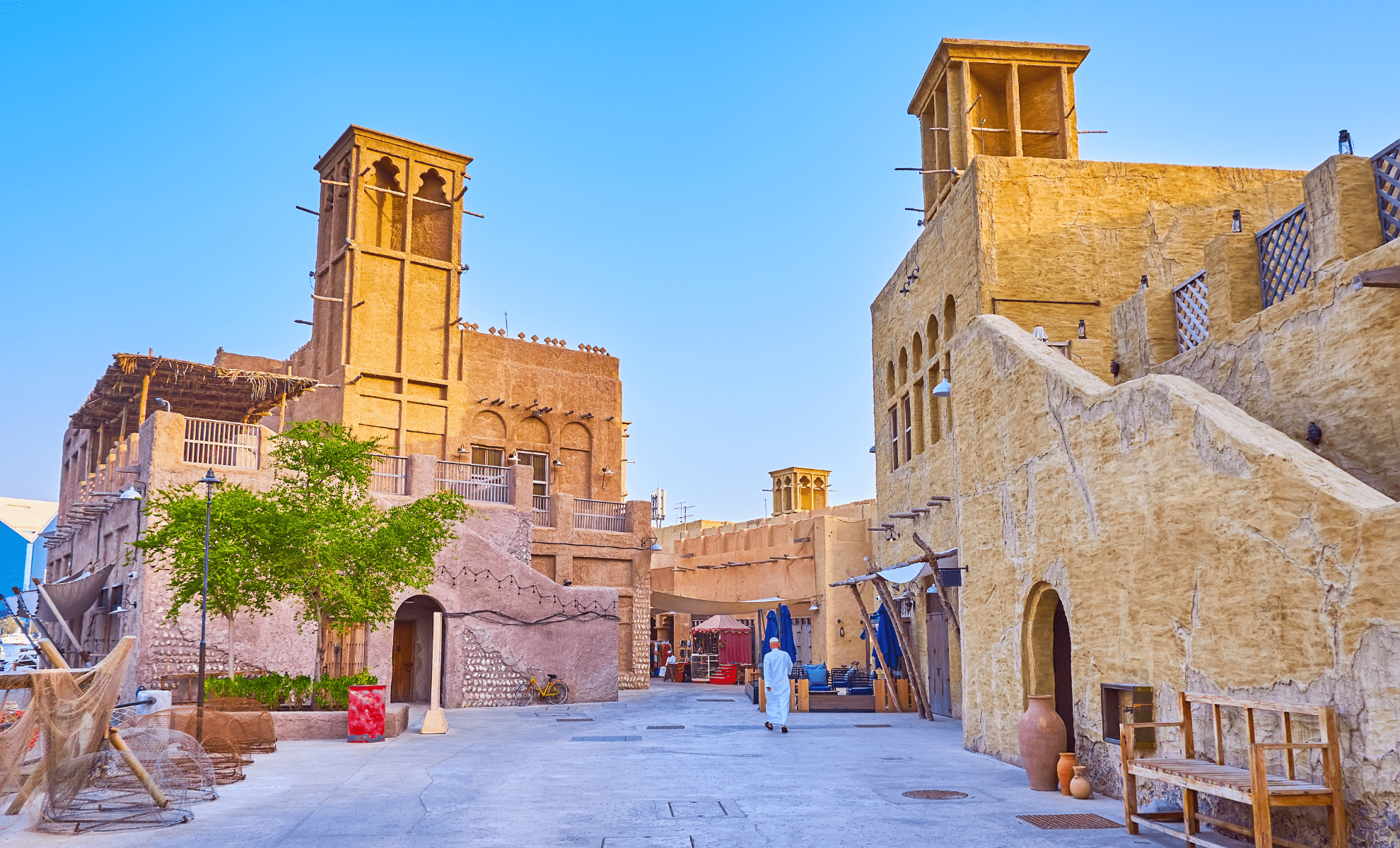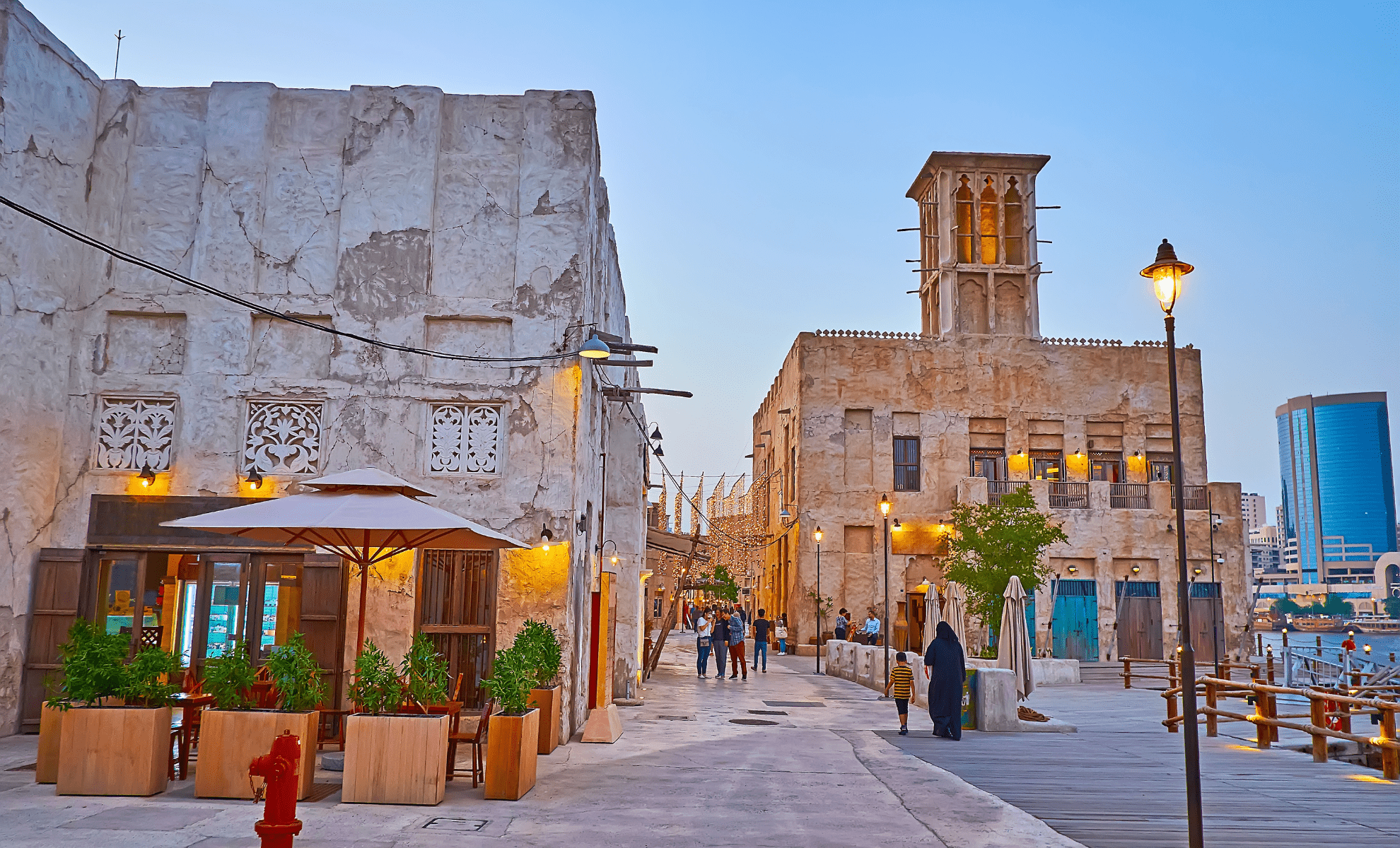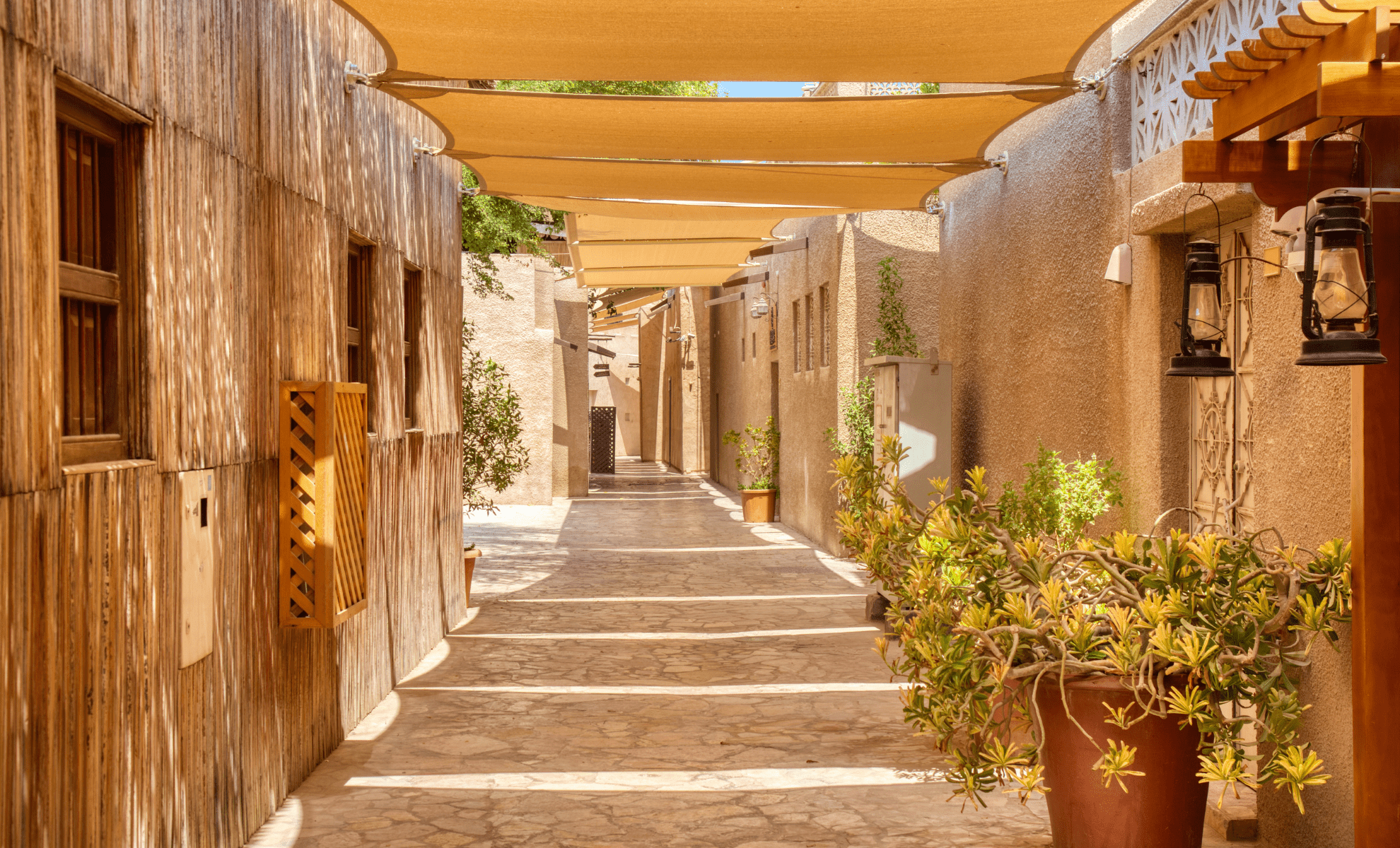Nestled in the heart of Dubai's bustling metropolis lies a hidden gem that transports visitors back in time. The Al Fahidi Historical Neighbourhood, also known as Al Bastakiya, is a charming district that preserves the city's rich cultural heritage and showcases its historic past.
The neighbourhood dates back to the 19th century when it was established by wealthy merchants from Persia who settled in Dubai. The area became a hub for trade and commerce, with bustling souks and markets selling everything from spices to textiles.
Today, Al Fahidi Historical Neighbourhood is a testament to Dubai's humble beginnings and its rapid transformation into a global hub for business and tourism. The neighbourhood also houses several museums that offer insights into Dubai's history, culture, and traditions.
Al Fahidi Historical Neighbourhood is more than just an ode to Dubai's past; it serves as a reminder of the city's commitment to preserving its heritage amidst rapid modernisation. A visit here is not only an opportunity to immerse oneself in history but also an opportunity to appreciate how far this vibrant city has come.
History of Al Fahidi historical neighbourhood
The Al Fahidi Historical Neighbourhood became a hub for trade and commerce, with bustling souks and markets selling everything from spices to textiles. The neighbourhood's prime location along Dubai Creek made it an ideal spot for traders to dock their boats and unload their merchandise.
The architecture of the buildings in Al Fahidi Historical Neighbourhood is unique and represents the traditional Emirati style. Most of the houses are made of coral, stone, and gypsum, with intricate designs that served as natural air conditioning systems before modern technology. The wind-tower houses are particularly noteworthy for their elaborate designs that not only provide ventilation but also showcase the craftsmanship of local artisans.
Al Fahidi Historical Neighbourhood has witnessed several significant events that shaped Dubai's history over the years. One such event was the arrival of oil companies in the 1930s which transformed Dubai's economy from a trading port to an oil-rich nation. Another important event was the establishment of Dubai Municipality in 1954 which led to significant improvements in infrastructure and public services throughout the city.
In addition to these events, Al Fahidi Historical Neighbourhood played a crucial role during World War II when it served as a base for British forces stationed in Dubai. The neighbourhood was strategically located near vital shipping lanes which made it an ideal location for defence purposes.
Despite its rich history, Al Fahidi Historical Neighbourhood faced threats of demolition during the 1970s due to urban development plans. However, thanks to efforts by local conservationists and government officials, this unique neighbourhood was preserved and restored to its former glory.
Today, visitors can explore this historic gem on foot or by bike while admiring its timeless architecture and learning about its rich history through museums like the Sheikh Mohammed Centre for Cultural Understanding or XVA Gallery. A visit to Al Fahidi Historical Neighbourhood offers a glimpse into Dubai's past while celebrating its present-day achievements as a global city at the forefront of innovation and progress.

Things to do in Al Fahidi historical neighbourhood
Al Fahidi Historical Neighbourhood is not only a testament to Dubai's rich cultural heritage and historic past but also offers visitors a multitude of things to see and do. Touring the historical buildings and museums is a must-do when visiting this neighbourhood. These buildings offer insights into the daily lives of people in Dubai during the 19th century, showcasing their customs, traditions, and architecture.
One such museum is the Dubai Museum located in Al Fahidi Fort. Built in 1787, this fort served as a residence for ruling families, a garrison, and even a prison before being converted into a museum in 1971. The museum features exhibits on Dubai's history, culture, and way of life during ancient times.
Art enthusiasts will be delighted by the numerous art galleries that can be found within Al Fahidi Historical Neighbourhood. XVA Gallery is one such gallery that showcases contemporary art from local artists as well as international artists with ties to the region.
After touring the museums and galleries, visitors can indulge in traditional Emirati cuisine at local restaurants and cafes. The Arabian Tea House serves authentic Emirati dishes like machboos (spiced rice with meat or fish) and luqaimat (sweet dumplings). Visitors can also try Arabic coffee or tea while enjoying shisha (flavoured tobacco smoked through water pipes) at one of the many cafes in the neighbourhood.
Lastly, shopping for souvenirs at local markets should not be missed when visiting Al Fahidi Historical Neighbourhood. The Textile Souk offers an array of fabrics including silk, cotton, and linen while the Spice Souk boasts exotic spices like saffron, cardamom, cinnamon, and more. Visitors can also find traditional handicrafts like pottery, carpets, and jewellery made by local artisans at these markets.
How to get to Al Fahidi historical neighbourhood
Getting to Al Fahidi Historical Neighbourhood is relatively easy due to its central location within Dubai. Here are a few options for visitors looking to explore this historic district:
- Public Transportation: Visitors can take the Dubai Metro's Green Line and get off at the Al Fahidi station which is just a few minutes walk from the neighbourhood. Alternatively, visitors can take a bus to Al Ghubaiba Bus Station which is also located nearby.
- Taxi or Ride-Hailing Services: Taxi and ride-hailing services like Uber and Careem are widely available in Dubai and offer a convenient way to get around the city. Visitors can simply input "Al Fahidi Historical Neighbourhood" into their preferred app and follow the directions to reach their destination.
- Personal Vehicle: Visitors who have rented a car or have a vehicle can easily navigate to Al Fahidi Historical Neighbourhood using GPS or by following road signs indicating the direction towards Bur Dubai.
Once visitors arrive at Al Fahidi Historical Neighbourhood, they can explore the area on foot or rent bicycles available for hire in the neighbourhood. The narrow streets of this historic district are pedestrian-friendly, making it easy for visitors to wander around while admiring its unique architecture and taking in its rich cultural heritage. Whether visitors prefer public transportation, taxis, ride-hailing services or personal vehicles; there are several ways to reach this historic district with ease.

Tips on when to visit based on season and weather conditions
When planning a visit to Al Fahidi Historical Neighbourhood, it is important to consider the season and weather conditions in Dubai as they can impact the overall experience. Here are some tips on when to visit based on season and weather conditions:
- Winter Season (November - March): This is considered the best time to visit Al Fahidi Historical Neighbourhood as temperatures are mild and pleasant, making it ideal for exploring the neighbourhood on foot. The average temperature during this season ranges from 14°C to 26°C. Visitors can expect clear skies with minimal rainfall and low humidity levels, making outdoor activities more enjoyable.
- Summer Season (May - September): This is considered the off-season for tourism in Dubai due to high temperatures and humidity levels. Temperatures can soar up to 45°C during the day, making it uncomfortable for visitors to explore the neighbourhood outdoors. However, visitors can still enjoy indoor activities like visiting museums and art galleries or indulging in traditional Emirati cuisine at local restaurants.
- Shoulder Seasons (April & October): These months are considered shoulder seasons as they fall between peak and off-peak seasons. During these months, visitors can expect mild temperatures with occasional rainfall which makes exploring this neighbourhood more comfortable than during the summer months.
- Ramadan: Ramadan is a significant religious event in Dubai where Muslims fast from sunrise until sunset for a month. During this period, many restaurants may be closed during daytime hours but open after sunset until late at night offering iftar meals which break the fasts of Muslims along with suhoor meals before fasting begins again at dawn.
So, the best time to visit Al Fahidi Historical Neighbourhood is during the winter season when temperatures are mild and pleasant, allowing for comfortable exploration of this historic district on foot.

Final thoughts
Al Fahidi Historical Neighbourhood is a must-visit destination for anyone travelling to Dubai. This historic district offers visitors a glimpse into the rich cultural heritage of Dubai, showcasing traditional Emirati architecture and offering an array of activities that cater to all interests. Here is a recap of why visitors should consider visiting Al Fahidi Historical Neighbourhood during their stay in Dubai:
- Cultural Experience: Al Fahidi Historical Neighbourhood offers visitors an opportunity to experience the unique blend of cultures that make up Dubai's identity. The neighbourhood's narrow streets and alleys are lined with traditional buildings made from coral and gypsum, which date back to the 19th century. Visitors can explore these buildings, which have been converted into museums, art galleries, and cafes, offering a glimpse into Emirati culture.
- Walking Tours: One of the best ways to explore Al Fahidi Historical Neighbourhood is on foot. Visitors can take walking tours that are led by experienced guides who provide insights into the neighbourhood's history and culture while pointing out landmarks and attractions along the way.
- Art Galleries: Al Fahidi Historical Neighbourhood has become a hub for contemporary art in Dubai with several art galleries showcasing works by local artists as well as international artists with ties to the region. Visitors can enjoy exhibitions featuring paintings, sculptures, and installations or even attend workshops organised by these galleries.
- Traditional Cuisine: The neighbourhood has several restaurants serving traditional Emirati cuisine such as Machboos (rice dish), Luqaimat (sweet dumplings), Balaleet (sweet vermicelli). A visit to Al Fahidi Historical Neighbourhood would not be complete without indulging in these culinary delights at local restaurants or cafes.
- Souvenir Shopping: The neighbourhood has several markets selling souvenirs such as handmade pottery, textiles, jewellery or even spices making it perfect for those looking for unique gifts or keepsakes from their trip to Dubai.
Overall, Al Fahidi Historical Neighbourhood offers an array of activities that cater to all interests, making it an ideal destination for families, couples or solo travellers looking for an authentic cultural experience in Dubai. A visit to this historic district will leave visitors with memories that will last a lifetime!